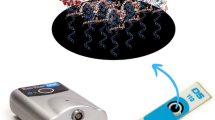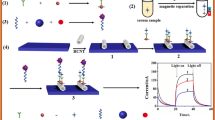Abstract
An immunosensor with rapid and ultrasensitive response for vascular endothelial growth factor (VEGF) has been built up with 4-aminothiophenol (4-ATP) onto the gold surfaces. Quantitative analysis of VEGF was performed by recording the impedance changing of the gold electrode surface by binding of VEGF. The human vascular endothelial growth factor receptor 1 (VEGF-R1, Flt-1) was used as a biorecognition element for the first time in the literature. VEGF-R1 was covalently immobilized via 4-ATP self-assembled monolayer formed on gold thin film covered surface. Construction of the biosensor was carefully characterised by the techniques such as electrochemistry and electrochemical impedance spectroscopy. In order to characterize impedance data, Kramers–Kronig transform was performed on the experimental impedance data. The limit of detection of the immunosensor for qualitative detection was 100 pg/mL while the LOD for quantitative detection could down to 100 pg/mL by using the VEGF-R1 based biosensor. Finally, artificial serum samples spiked with VEGF was analyzed by the proposed immunosensor to investigate useful of the biosensor for early biomarker diagnosis.








Similar content being viewed by others
References
Ball P (1994) Designing the molecular world. Princeton University, Princeton
Byon HR, Choi HC (2006) Network single-walled carbon nanotube-field effect transistors (SWNT-FETs) with increased Schottky contact area for highly sensitive biosensor applications. J Am Chem Soc 128:2188–2189
Clark-Raymond A, Halaris A (2013) VEGF and depression: a comprehensive assessment of clinical data. J Psychiatr Res 47:1080–1108
Cui Y, Wei Q, Park H, Lieber CM (2001) Nanowire nanosensors for highly sensitive and selective detection of biological and chemical species. Science 293(17):1289–1292
Ehm W, Gohr H, Kaus R, Roseler B, Schiller C (2000) The evaluation of electrochemical impedance spectra using a modified logarithmic hilbert transform. ACH Mod Chem 137:145–157
Folkman J (1995) Seminars in medicine of the beth Israel Hospital, Boston. Clinical applications of research on angiogenesis. N Engl J Med 333:1757–1763
Gao Z, Agarwal A, Trigg AD et al (2007) Silicon nanowire arrays for label-free detection of DNA. Anal Chem 79:3291–3297
Gooding JJ, Mearns F, Yang W, Liu J (2003) Protein electrochemistry using aligned carbon nanotube arrays. Electroanalysis 15:81–96
Hahm J, Lieber CM (2004) Direct ultrasensitive electrical detection of DNA and DNA sequence variations using nanowire nanosensors. Nano Lett 4:51–54
Hoshina D, Abe R, Yoshioka N et al (2013) Establishment of a novel experimental model of human angiosarkoma and a-VEGF targeting therapeutic experiment. J Dermatol Sci 70(2):116–122
Huang QA, Hui R, Wang B, Zhang J (2007) A review of AC impedance modeling and validation in SOFC diagnosis. Electrochim Acta 52:8144–8164
Johannes S, Carola R, Katinka A et al (2013) Ulf Müller-Ladner linking systemic angiogenic factors (VEGF, angiogenin, TIMP-2) and Doppler ultrasound to anti-inflammatory treatment in rheumatoid arthritis. Joint Bone Spine 80:270–273
Jonathan GR, Alejandro ZD (2013) Vascular permeability changes involved in tumor metastasis. Cancer Lett 335:259–269
Kendall RL, Thomas KA (1993) Inhibition of vascular endothelial cell growth factor activity by an endogenously encoded soluble receptor. Proc Natl Acad Sci USA 90(22):10705–10709
Kim A, Ah CS, Yu HY, Yang J-H et al (2007) Ultrasensitive, label-free, and real-time immunodetection using silicon field-effect transistors. Appl Phys Lett 91:103901–103903
Kim G, Kim KW, Oh MK, Sung YM (2010) Electrochemical detection of vascular endothelial growth factors (VEGFs) using VEGF antibody fragments modified Au NPs/ITO electrode. Biosens Bioelectron 25:1717–1722
Kramers HA (1929) Die dispersion und absorption von Rontgenstrahlen. Phys Zeits 30:522–523
Kronig RL (1926) On the theory of dispersion of X-rays. J Opt Soc Am Rev Sci Instrum 12:547–557
Lee H-S, Kim KS, Kim C-J et al (2009) Electrical detection of VEGFs for cancer diagnoses using anti-vascular endothelial growth factor aptamer modified Si nanowire FETs. Biosens Bioelectron 24(6):1801–1805
Longo R, Gasparini G (2007) Challenges for patient selection with VEGF inhibitors. Cancer Chemother Pharm 60:151–170
Lu B, Xie J, Lu C, Wu C, Wei Y (1995) Oriented immobilization of fab’ fragments on silica surfaces. Anal Chem 67(1):83–87
Neufeld G, Cohen T, Gengrinovitch S, Poltorak Z (1999) Vascular endothelial growth factor (VEGF) and its receptors. FASEB J 13(1):9–22
Nuzzo RG, Allara DL (1983) Adsorption of bifunctional organic disulfides on gold surfaces. J Am Chem Soc 105:4481–4483
Orazem ME, Tribollet B (2008) Electrochemical impedance spectroscopy. Wiley, New Jersey
Pajkossy TJ (1994) Impedance of rough capacitive electrodes. Electroanal Chem 364:111–124
Patolsky F, Zheng G, Hayden O et al (2004) Electrical detection of single viruses. Proc Natl Acad Sci USA 101:14017–14022
Prabhulkar S, Alwarappan S, Liu G, Li C-Z (2009) Amperometric micro-immunosensor for the detection of tumor biomarker. Biosens Bioelectron 24(12):3524–3530
Randles JEB (1947) Kinetics of rapid electrode reactions. Discuss Faraday Soc 1:11
Schreiber F (2000) Structure and growth of self-assembling monolayers. Prog Surf Sci 65:151–256
Shibuya M, Claesson-Welsh L (2006) Signal transduction by VEGF receptors in regulation of angiogenesis and lymphangiogenesis. Exp Cell Res 312:549–560
Shibuya M, Yamaguchi S, Yamane A et al (1990) Nucleotide sequence and expression of a novel human receptor-type tyrosine kinase gene (flt) closely related to the fms family. Oncogene 5(4):519–524
Stern E, Klemic JF, Routenberg DA et al (2007) Reed, label-free immunodetection with CMOS-compatible semiconducting nanowires. Nature 445:519–522
Tidwell C, Ertel S, Ratner B et al (1997) Endothelial cell growth and protein adsorption on terminally functionalized, self-assembled monolayers of alkanethiolates on gold. Langmuir 13:3404–3413
Ulman A (1996) Formation and structure of self-assembled monolayers. Chem Rev 96:533–1554
Veikkola T, Alitalo K (1999) VEGFs, receptors and angiogenesis. Semin Cancer Biol 9:211–220
Wallace DK, Wu KY (2013) Current and future trends in treatment of severe of retinopathy prematurity. Clin Perinatol 40:297–310
Witmer AN, Dai J, Weich HA et al (2002) Expression of vascular endothelial growth factor receptors 1, 2, and 3 in quiescent endothelia. J Histochem Cytochem 50(6):767–777
Witmer AN, Vrensen GF, Van Noorden CJ, Schlingemann RO (2003) Vascular endothelial growth factors and angiogenesis in eye disease. Prog Retin Eye Res 22:1–29
Zampetti A, Gnarra M, Borsini W et al (2013) Vascular endothelial growth factor (VEGF-a) in fabry disease: association with cutaneous and systemic manifestations with vascular involvement. Cytokine 61(3):933–939
Acknowledgments
The authors greatly appreciate the support of the TÜBİTAK (The Scientific and Technological Research Council of Turkey, Project number: 109 T 172).
Conflict of interest
Mustafa Teke, Çiğdem Sayıklı, Çetin Canbaz, Mustafa Kemal Sezgintürk declare that they have no conflict of interest.
Informed Consent
All procedures followed were in accordance with the ethical standards of the responsible committee on human experimentation (institutional and national) and with the Helsinki Declaration of 1975, as revised in 2000 (5). Informed consent was obtained from all patients for being included in the study.
Statement of Human and Animal Rights
All institutional and national guidelines for the care and use of laboratory animals were followed. All procedures followed were in accordance with the ethical standards of the responsible committee on human experimentation (institutional and national) and with the Helsinki Declaration of 1975, as revised in 2008 (5). Informed consent was obtained from all patients for being included in the study.
Author information
Authors and Affiliations
Corresponding author
Rights and permissions
About this article
Cite this article
Teke, M., Sayıklı, Ç., Canbaz, Ç. et al. A Novel Biosensing System Using Biological Receptor for Analysis of Vascular Endothelial Growth Factor. Int J Pept Res Ther 20, 221–230 (2014). https://doi.org/10.1007/s10989-013-9386-4
Accepted:
Published:
Issue Date:
DOI: https://doi.org/10.1007/s10989-013-9386-4




